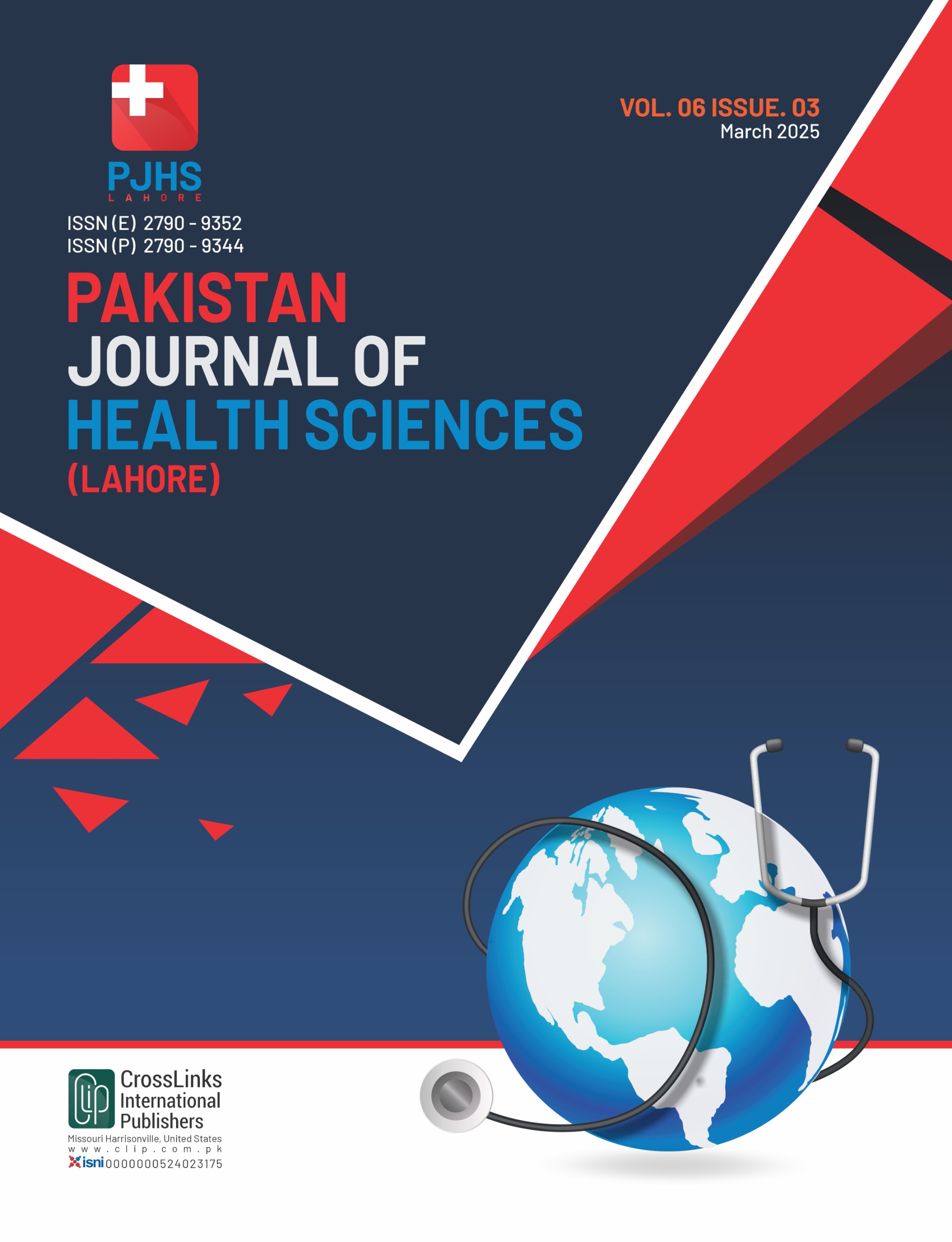Comparison of Trichoscopic Features of Alopecia Areata before and after Treatment with Intralesional Steroids
Trichoscopic Features of Alopecia Areata with Intralesional Steroids
DOI:
https://doi.org/10.54393/pjhs.v6i3.2773Keywords:
Alopecia Areata, Intralesional, Triamcinolone Acetonide, TrichoscopyAbstract
Alopecia Areata is a common form of non-scarring hair loss. The utility of Trichoscopy lies in diagnosis and monitoring therapeutic response in challenging cases. Objectives: To compare the change in frequency of trichoscopic features of Alopecia Areata before and after treatment with intralesional steroids. Methods: This descriptive longitudinal study was carried out in the Department of Dermatology, Sahiwal Teaching Hospital, Sahiwal. Patients between age 18 to 60 of either sex, having Severity of Alopecia Tool (SALT Score) of less than 50 were enrolled. Intralesional triamcinolone acetate (5mg/ml with lignocaine) was infiltrated at a dose of 0.1 ml /cm2 into the dermis. Trichoscopic features were recorded using Heine Delta 30 digital Dermatoscope at baseline and after 12 weeks. Results: Mean age was 28.19 ± 8.54. There was statistically significant decrease in mean of SALT Score before (9.91 ± 6.77) and after (4.94 ± 4.04) treatment. The frequency of black dots, exclamation mark hairs and yellow dots at baseline was 91%, 81% and 23%. After treatment these frequencies reduced significantly to 8%, 7%, and 9% respectively (p-value<0.001). While the proportion of short vellus hair and circle hair at baseline (63%,12%) increased to 99% and 70% after treatment respectively (p-value<0.001). Conclusions: It was concluded that clinical improvement in Alopecia Areata after treatment with intralesional steroids can be demonstrated with disappearance of yellow dots, black dots, exclamation mark hair and appearance of circle and short regrowing hair on Trichoscopy. Thus, highlighting the utility of Trichoscopy as a valuable tool for monitoring therapeutic response in Alopecia Areata.
References
Simakou T, Butcher JP, Reid S, Henriquez FL. Alopecia Areata: A Multifactorial Autoimmune Condition. Journal of Autoimmunity. 2019 Mar; 98: 74-85. doi: 10.1016/j.jaut.2018.12.001. DOI: https://doi.org/10.1016/j.jaut.2018.12.001
Us Salam S, Rafiq Z, Aziz N, Anwar A. Frequency of Alopecia Areata with Other Autoimmune Disorders. The Professional Medical Journal. 2022 Jan; 29(02): 227-31. doi: 10.29309/TPMJ/2022.29.02.6565. DOI: https://doi.org/10.29309/TPMJ/2022.29.02.6565
Lee HH, Gwillim E, Patel KR, Hua T, Rastogi S, Ibler E et al. Epidemiology of Alopecia Areata, Ophiasis, Totalis, and Universalis: A Systematic Review and Meta-Analysis. Journal of the American Academy of Dermatology. 2020 Mar; 82(3): 675-82. doi: 10.1016/j.jaad.2019.08.032. DOI: https://doi.org/10.1016/j.jaad.2019.08.032
Bertolini M, McElwee K, Gilhar A, Bulfone‐Paus S, Paus R. Hair Follicle Immune Privilege and Its Collapse in Alopecia Areata. Experimental Dermatology. 2020 Aug; 29(8): 703-25. doi: 10.1111/exd.14155. DOI: https://doi.org/10.1111/exd.14155
Abarca YA, Scott-Emuakpor R, Tirth J, Moroz O, Thomas GP, Yateem D et al. Alopecia Areata: Understanding the Pathophysiology and Advancements in Treatment Modalities. Cureus. 2025 Jan: 17(1). doi: 10.7759/cureus.78298. DOI: https://doi.org/10.7759/cureus.78298
Meah N, Wall D, York K, Bhoyrul B, Bokhari L, Sigall DA et al. The Alopecia Areata Consensus of Experts (ACE) study: Results of an international Expert Opinion On Treatments for Alopecia Areata. Journal of the American Academy of Dermatology. 2020 Jul; 83(1): 123-30. doi: 10.1016/j.jaad.2020.03.004. DOI: https://doi.org/10.1016/j.jaad.2020.03.004
Waśkiel A, Rakowska A, Sikora M, Olszewska M, Rudnicka L. Trichoscopy of Alopecia Areata: An Update. The Journal of Dermatology. 2018 Jun; 45(6): 692-700. doi: 10.1111/1346-8138.14283. DOI: https://doi.org/10.1111/1346-8138.14283
Lacarrubba F, Micali G, Tosti A. Scalp Dermoscopy or Trichoscopy. Current Problems in Dermatology. 2015 Feb; 47: 21-32. doi: 10.1159/000369402. DOI: https://doi.org/10.1159/000369402
Ganjoo S and Thappa DM. Dermoscopic Evaluation of Therapeutic Response to an Intralesional Corticosteroid in the Treatment of Alopecia Areata. Indian Journal of Dermatology, Venereology and Leprology. 2013 May; 79: 408. doi: 10.4103/0378-6323.110767. DOI: https://doi.org/10.4103/0378-6323.110767
Albadri W and Inamadar AC. Comparison of Clinical Efficacy and Trichoscopic Changes in Alopecia Areata of the Scalp following Treatment with Intralesional Triamcinolone Acetonide and Autologous Platelet-Rich Plasma. Clinical Dermatology Review. 2023 Jul; 7(3): 229-33. doi: 10.4103/cdr.cdr_14_22. DOI: https://doi.org/10.4103/cdr.cdr_14_22
Fawzy MM, Abdel Hay R, Mohammed FN, Sayed KS, Ghanem ME, Ezzat M. Trichoscopy as an Evaluation Method for Alopecia Areata Treatment: A Comparative Study. Journal of Cosmetic Dermatology. 2021 Jun; 20(6): 1827-36. doi: 10.1111/jocd.13739. DOI: https://doi.org/10.1111/jocd.13739
Divyalakshmi C, Hazarika N, Bhatia R, Upadhyaya A. Utility of Trichoscopy in Comparison to the Standard Methods for Assessing the Disease Activity, Severity, and Therapeutic Response in Alopecia Areata. Cosmoderma. 2023 Jun; 3. doi: 10.25259/CSDM_62_2023. DOI: https://doi.org/10.25259/CSDM_62_2023
Darchini-Maragheh E, Moussa A, Rees H, Jones L, Bokhari L, Sinclair R. Assessment of Clinician-Reported Outcome Measures for Alopecia Areata: A Systematic Scoping Review. Clinical and Experimental Dermatology. 2025 Feb; 50(2): 267-78. doi: 10.1093/ced/llae320. DOI: https://doi.org/10.1093/ced/llae320
Ageeba BA, Zaki AM, El Rewiny EM. Microneedling with Triamcinolone Acetonide versus Intralesional Triamcinolone Acetonide in Treatment of Alopecia Areata. Al-Azhar International Medical Journal. 2023; 4(2): 37. doi: 10.58675/2682-339X.1667. DOI: https://doi.org/10.58675/2682-339X.1667
Pirmez R. The dermatoscope in the Hair Clinic: Trichoscopy of Scarring and Nonscarring Alopecia. Journal of the American Academy of Dermatology. 2023 Aug; 89(2): S9-15. doi: 10.1016/j.jaad.2023.04.033. DOI: https://doi.org/10.1016/j.jaad.2023.04.033
Monica PA and Tiplica GS. Non-Invasive Techniques for Evaluating Alopecia Areata. Maedica. 2023 Jun; 18(2): 333. doi: 10.26574/maedica.2023.18.2.333. DOI: https://doi.org/10.26574/maedica.2023.18.2.333
Gómez-Quispe H, Moreno-Arrones OM, Hermosa-Gelbard Á, Vañó-Galván S, Saceda-Corralo D. [Translated article] Trichoscopy in Alopecia Areata. Actas Dermo-Sifiliograficas. 2023 Jan; 114(1): T25-32. doi: 10.1016/j.ad.2022.08.027. DOI: https://doi.org/10.1016/j.ad.2022.08.027
Al‐Dhubaibi MS, Alsenaid A, Alhetheli G, Abd Elneam AI. Trichoscopy Pattern in Alopecia Areata: A Systematic Review and Meta‐Analysis. Skin Research and Technology. 2023 Jun; 29(6): e13378. doi: 10.1111/srt.13378. DOI: https://doi.org/10.1111/srt.13378
El Sayed MH, Ibrahim NE, Afify AA. Superficial Cryotherapy versus Intralesional Corticosteroids Injection in Alopecia Areata: A Trichoscopic Comparative Study. International Journal of Trichology. 2022 Jan; 14(1): 8-13. doi: 10.4103/ijt.ijt_130_20. DOI: https://doi.org/10.4103/ijt.ijt_130_20
Sahu VK, Datta A, Sarkar T, Gayen T, Chatterjee G. Role of Trichoscopy in Evaluation of Alopecia Areata: A Study in A Tertiary Care Referral Centre in the Eastern India. Indian Journal of Dermatology. 2022 Mar; 67(2): 127-32. doi: 10.4103/ijd.ijd_577_21. DOI: https://doi.org/10.4103/ijd.ijd_577_21
Downloads
Published
How to Cite
Issue
Section
License
Copyright (c) 2025 Pakistan Journal of Health Sciences

This work is licensed under a Creative Commons Attribution 4.0 International License.
This is an open-access journal and all the published articles / items are distributed under the terms of the Creative Commons Attribution License, which permits unrestricted use, distribution, and reproduction in any medium, provided the original author and source are credited. For comments













